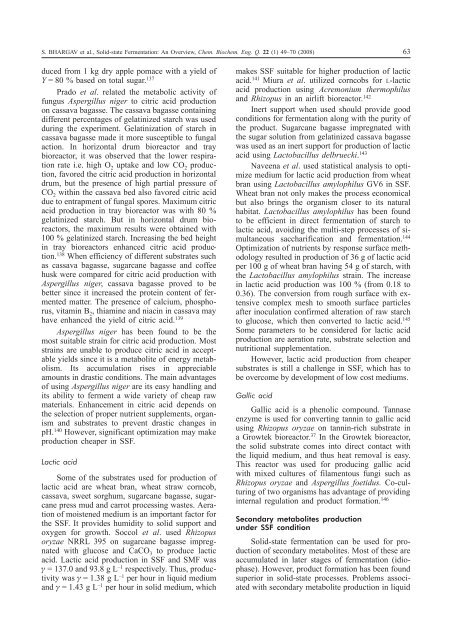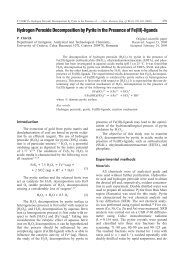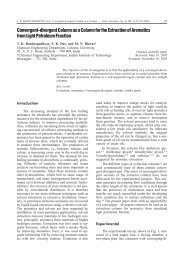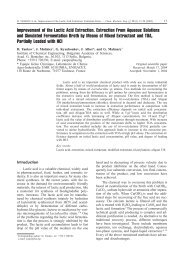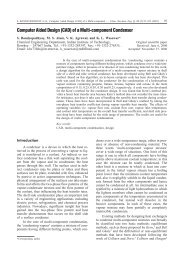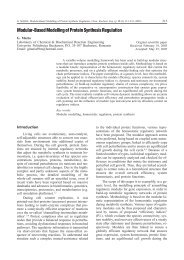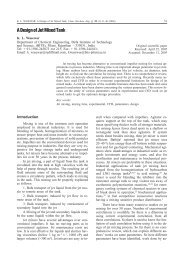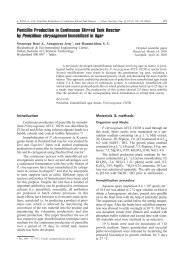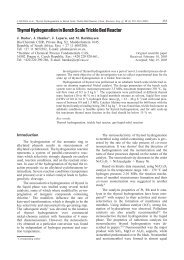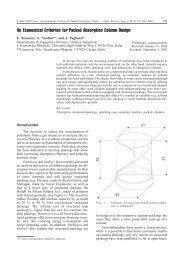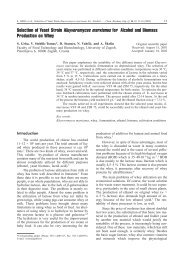62 S. BHARGAV et al., <strong>Solid</strong>-state <strong>Fermentation</strong>: <strong>An</strong> <strong>Overview</strong>, Chem. Biochem. Eng. Q. 22 (1) 49–70 (2008)for xylanase production in a horizontal bioreactorwith wheat straw and destarched wheat bran as substrate.125Pretreatment of lignocellulosic substrates wasfound to be advantageous in many cases, howeverin some it proved disadvantageous. 26 Pretreatmentfor xylanase production using wheat straw byAspergillus terreus resulted in reduction of enzymeactivity. 123 Some other molds that can be used forproduction of xylanase using SSF are Melanocarpusalbomyces, 126 Thermomyces lanuginosus, 127Humicola insolens 128 and Aureobusidium pullulans.129Production of organic acids under SSF<strong>Fermentation</strong> plays a key role in the productionof organic acids. The production of organic acidsprogressed with development of SSF. However,biotechnological processes for large-scale productionof organic acids are still in early phases of development.Organic acids are the most common ingredientsof food and beverages because of theirthree main properties: solubility, hygroscopic quality,and their ability to chelate. 130 Some of the acidsproduced using SSF are citric acid, lactic acid, gallicacid, fumaric acid, -linoleic acid, and kojicacid.Citric acidVarious agro-industrial residues such as sugarcanepress mud, coffee husk, wheat bran, cassavafibrous residue, de-oiled rice bran, carob pods, applepomace, grape pomace, kiwi fruit peels, okara,pineapple wastes, mausami wastes, kumara etc. aremost potential substrates for production of citricacid in SSF.<strong>Solid</strong>-state fermentation has been proved advantageousover SMF in many respects. Metal ionssuch as Fe +2 ,Mn +2 and Zn +2 repress biosynthesis ofcitric acid by Aspergillus niger in submerged fermentation,but this does not happen in SSF. It is reportedby Kumar et al. that addition of these metalions enhances production of citric acid by 1.4 – 1.9times in SSF. 3 Kumar et al. compared wheat branand sugarcane bagasse for maximum citric acidproduction with Aspergillus niger DS-1 strain. Sugarcanebagasse proved to be a better carrier whencompared with wheat bran. Agglomeration in wheatbran caused non-uniform mixing of the substrate,affected heat and mass transfer along with growthand product formation. Bagasse did not show agglomerationeven when moisture level was increasedfrom 65 % to 85 %. 3 Supplementation ofmethanol to agro-industrial residues enhanced citricacid production. Kumar et al. utilized pineapple,mixed fruit and mausami residues for producing citricacid using Aspergillus niger DS-1 in SSF.Supplementation of methanol to substrates wasdone at different moisture levels. Methanol being adehydrating agent enhanced the moisture requirementof substrates. In the presence of methanolsugar consumption decreased but citric acid productionincreased. The maximum citric acid yieldwas Y = 51.4, 46.5 and 50 % (based on sugar consumed)from pineapple, mixed fruit and mausamiresidues, respectively. 131 Similar reports with carobpods and corncobs have been published by Roukasand Hang et al., respectively. Addition of methanolto the substrate increased citric acid production.132,133 Figs were used for production of citricacid due to their high carbohydrate content andyielded 8 % citric acid. However, the addition ofmethanol increased citric acid production from64 – 490 g kg –1 dry fig. 134 Enhancement in citricacid also depends on other additives such as carbonand nitrogen sources and metal ions.Researchers have used different bioreactors forproduction of citric acid. Flasks proved their superiorityover tray and rotating drum bioreactors whencompared among different bioreactors using pineapplewaste as substrate for citric acid production,with strains of Aspergillus. 135 Packed bed reactorsproved their superiority when compared to flaskcultures in production of citric acid. Kumara,starch-containing substrate was used for citric acidproduction using Aspergillus niger with a packedbed bioreactor. Kinetic analysis of the packed bedbioreactor showed an overall reactor productivity ofP = 0.82 g h –1 citrate per kg wet mass kumara on 5 thday, which in the flask was 0.42 g h –1 citrate per kgwet mass kumara on 8 th day. Some adverse effectsof packed bed such as reactor blockage due to fungalbiomass, forced aeration and limited space,were dominated by optimizing particle size of substrate(d p = 4 – 8 mm) and airflow rate (Q =0.5–1.5Lmin –1 ). Higher bed height and larger particle sizeretard the citric acid production. Larger particle sizepromotes aeration at lower bed height in the reactor,which can destroy filamentous fungi. The high productivityin packed bed was due to initial utilizationof starch in the substrates for citric acid productionand occurrence of CO 2 throughout the process. 136However, some of the results above were contraindicatedwhen apple pomace was used as substratefor production of citric acid using Aspergillus nigerin packed bed bioreactor. Adjustment of the aerationrate provided sufficient O 2 to filamentousfungi, increase in bed height promoted physical stabilityand better air distribution in the reactor, optimummoisture content provided proper diffusion tofungal cells, and increase in particle size preventedcompaction of the substrate promoting aerationin the reactor. Hence, 124 g citric acid was pro-
S. BHARGAV et al., <strong>Solid</strong>-state <strong>Fermentation</strong>: <strong>An</strong> <strong>Overview</strong>, Chem. Biochem. Eng. Q. 22 (1) 49–70 (2008) 63duced from 1 kg dry apple pomace with a yield ofY = 80 % based on total sugar. 137Prado et al. related the metabolic activity offungus Aspergillus niger to citric acid productionon cassava bagasse. The cassava bagasse containingdifferent percentages of gelatinized starch was usedduring the experiment. Gelatinization of starch incassava bagasse made it more susceptible to fungalaction. In horizontal drum bioreactor and traybioreactor, it was observed that the lower respirationrate i.e. high O 2 uptake and low CO 2 production,favored the citric acid production in horizontaldrum, but the presence of high partial pressure ofCO 2 within the cassava bed also favored citric aciddue to entrapment of fungal spores. Maximum citricacid production in tray bioreactor was with 80 %gelatinized starch. But in horizontal drum bioreactors,the maximum results were obtained with100 % gelatinized starch. Increasing the bed heightin tray bioreactors enhanced citric acid production.138 When efficiency of different substrates suchas cassava bagasse, sugarcane bagasse and coffeehusk were compared for citric acid production withAspergillus niger, cassava bagasse proved to bebetter since it increased the protein content of fermentedmatter. The presence of calcium, phosphorus,vitamin B 2 , thiamine and niacin in cassava mayhave enhanced the yield of citric acid. 139Aspergillus niger has been found to be themost suitable strain for citric acid production. Moststrains are unable to produce citric acid in acceptableyields since it is a metabolite of energy metabolism.Its accumulation rises in appreciableamounts in drastic conditions. The main advantagesof using Aspergillus niger are its easy handling andits ability to ferment a wide variety of cheap rawmaterials. Enhancement in citric acid depends onthe selection of proper nutrient supplements, organismand substrates to prevent drastic changes inpH. 140 However, significant optimization may makeproduction cheaper in SSF.Lactic acidSome of the substrates used for production oflactic acid are wheat bran, wheat straw corncob,cassava, sweet sorghum, sugarcane bagasse, sugarcanepress mud and carrot processing wastes. Aerationof moistened medium is an important factor forthe SSF. It provides humidity to solid support andoxygen for growth. Soccol et al. used Rhizopusoryzae NRRL 395 on sugarcane bagasse impregnatedwith glucose and CaCO 3 to produce lacticacid. Lactic acid production in SSF and SMF was = 137.0 and 93.8 g L –1 respectively. Thus, productivitywas = 1.38 g L –1 per hour in liquid mediumand = 1.43 g L –1 per hour in solid medium, whichmakes SSF suitable for higher production of lacticacid. 141 Miura et al. utilized corncobs for L-lacticacid production using Acremonium thermophilusand Rhizopus in an airlift bioreactor. 142Inert support when used should provide goodconditions for fermentation along with the purity ofthe product. Sugarcane bagasse impregnated withthe sugar solution from gelatinized cassava bagassewas used as an inert support for production of lacticacid using Lactobacillus delbruecki. 143Naveena et al. used statistical analysis to optimizemedium for lactic acid production from wheatbran using Lactobacillus amylophilus GV6 in SSF.Wheat bran not only makes the process economicalbut also brings the organism closer to its naturalhabitat. Lactobacillus amylophilus has been foundto be efficient in direct fermentation of starch tolactic acid, avoiding the multi-step processes of simultaneoussaccharification and fermentation. 144Optimization of nutrients by response surface methodologyresulted in production of 36 g of lactic acidper 100 g of wheat bran having 54 g of starch, withthe Lactobacillus amylophilus strain. The increasein lactic acid production was 100 % (from 0.18 to0.36). The conversion from rough surface with extensivecomplex mesh to smooth surface particlesafter inoculation confirmed alteration of raw starchto glucose, which then converted to lactic acid. 145Some parameters to be considered for lactic acidproduction are aeration rate, substrate selection andnutritional supplementation.However, lactic acid production from cheapersubstrates is still a challenge in SSF, which has tobe overcome by development of low cost mediums.Gallic acidGallic acid is a phenolic compound. Tannaseenzyme is used for converting tannin to gallic acidusing Rhizopus oryzae on tannin-rich substrate ina Growtek bioreactor. 37 In the Growtek bioreactor,the solid substrate comes into direct contact withthe liquid medium, and thus heat removal is easy.This reactor was used for producing gallic acidwith mixed cultures of filamentous fungi such asRhizopus oryzae and Aspergillus foetidus. Co-culturingof two organisms has advantage of providinginternal regulation and product formation. 146Secondary metabolites productionunder SSF condition<strong>Solid</strong>-state fermentation can be used for productionof secondary metabolites. Most of these areaccumulated in later stages of fermentation (idiophase).However, product formation has been foundsuperior in solid-state processes. Problems associatedwith secondary metabolite production in liquid
- Page 1 and 2: S. BHARGAV et al., Solid-state Ferm
- Page 3 and 4: S. BHARGAV et al., Solid-state Ferm
- Page 6 and 7: 54 S. BHARGAV et al., Solid-state F
- Page 8 and 9: 56 S. BHARGAV et al., Solid-state F
- Page 10 and 11: 58 S. BHARGAV et al., Solid-state F
- Page 12 and 13: 60 S. BHARGAV et al., Solid-state F
- Page 16 and 17: 64 S. BHARGAV et al., Solid-state F
- Page 18 and 19: 66 S. BHARGAV et al., Solid-state F
- Page 20 and 21: 68 S. BHARGAV et al., Solid-state F
- Page 22: 70 S. BHARGAV et al., Solid-state F


